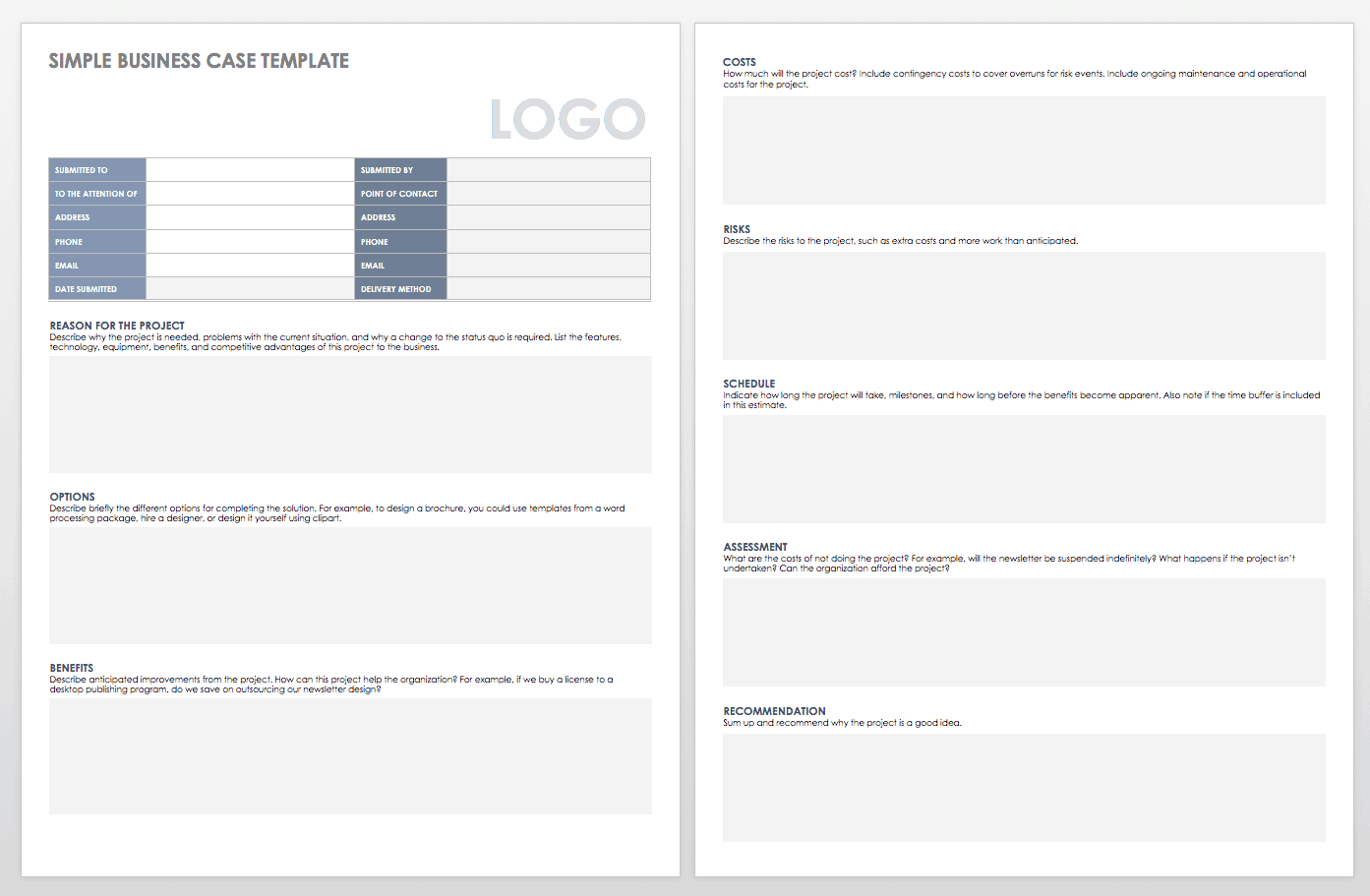
- Visually Represent Data: Charts and graphics not only help tell a story — they help people track metrics, detect trends, and determine growth at a glance.
- “Always Be Branding”: Your business report is not just a planning document — it is reflective of your company’s brand. Incorporate your company’s logo, and alter any template colors to match your company’s.
- “Always Be Learning”: With your business reports, you’re building an archive of research into what did and did not work. Business reports are easy ways to encapsulate data, projects, proposals, and plans, and you can always return to them as a research platform when planning your next initiative.
- Summarize and Condense: The most important thing that business reports should provide is clarity. Luckily, business reports are an easy way to visually depict data and streamline information into an easy-to-digest format. Always keep in mind the most concise way to communicate an idea more simply, directly, and effectively.
To learn more about this process and to find additional resources, read “Free Strategic Planning Templates.”
No two business report types are completely alike, but how do you ensure that you’re optimizing all of these communications in order to maximize results? You may be reporting on your sales growth, presenting a business plan or budget, showing market research, or giving a presentation on quarterly figures. These require different business report template types, but you can apply some general best practices to most business report template types.
Below is a list of some key elements typically included in a business report:
Common Elements in a Business Report
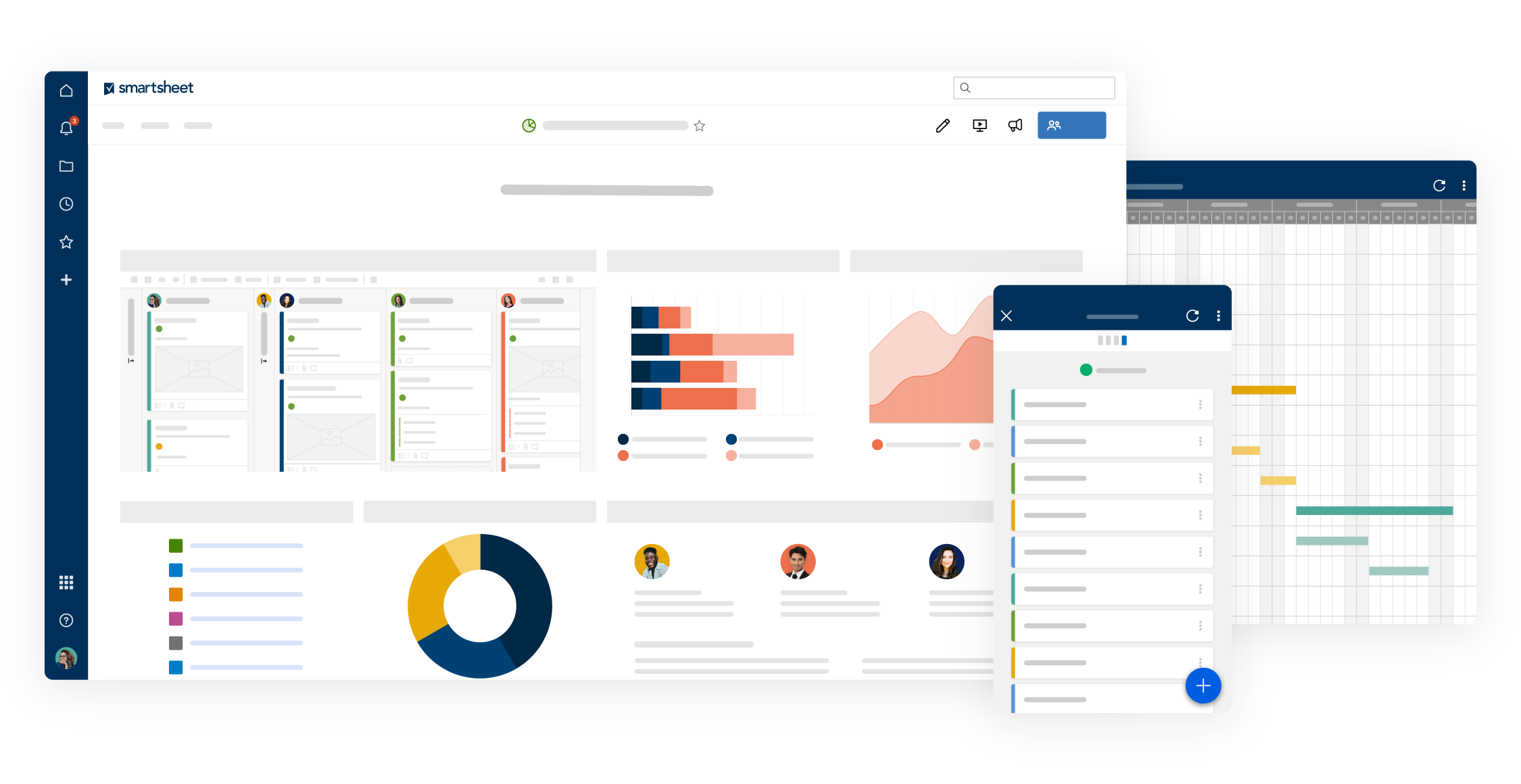
- Executive Summary: Include an overview of your project that addresses brief business background, project objectives, risks and issues, progress, outcomes, and customer profile details.
- Financial Evaluation: Enter investment expenditure and methods, expected productivity, and projected financial ranking information.
- Key Project Activities: List project-specific activities required for a winning project.
- Market Analysis: Provide a market description, pricing structure, your target audience, and other market analysis-related details.
- Marketing Assessment: Detail price, product, place, and promotion specifics for the project.
- Operational Planning: Specify business models, along with your financial plan, management, and business structures (as are relevant to the project in question).
- SWOT Analysis: A SWOT analysis identifies strengths, weaknesses, opportunities, and threats — both internal and external — related to your project.
To learn more about this process and to find additional resources, read “Free End of Year Report Templates.”
To learn more about this process and to find additional resources, read “Free Startup Plan, Budget & Cost Templates.”
A business plan executive summary presents stakeholders with a broad-strokes preview of what is usually included in a more detailed business plan report. In short, it provides them with the essence of your business plan. After reading the summary, readers should understand your business plan’s mission, end goals, and all details in between. This template provides space to include your company’s mission and vision, a description of products and services, value proposition, market analysis, financials, and more.
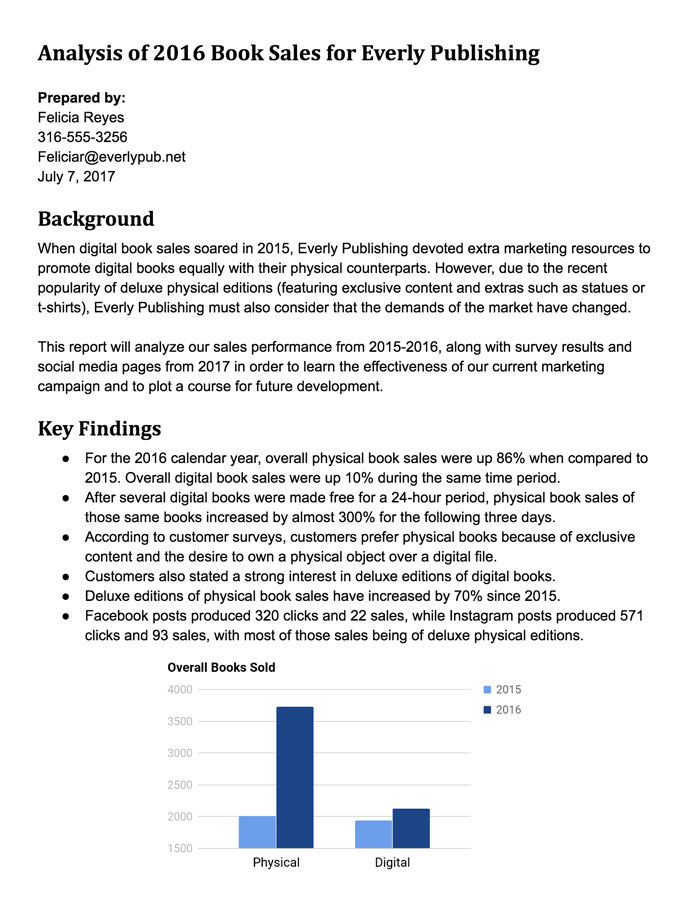
The layout of the front matter is simple and effective, while the background sets the stage in a quick, specific manner. The key findings provide the main takeaways that warrant further investigation, along with a chart to add emphasis and visual variety.
Business reports are always formal, objective, and heavily researched. Every fact must be clear and verifiable, regardless of whether the report focuses on a single situation or examines the overall performance of an entire company.
To demonstrate the principles of this lesson, we’ve created a brief business report for you to review.
As mentioned in Business Writing Essentials, revision is key to producing an effective document. Review your writing to keep it focused and free of proofreading errors, and ensure your factual information is correct and presented objectively. We also recommend you get feedback from a colleague before submitting your work because they can spot errors you missed or find new opportunities for analysis or discussion.
Revision
Once you’ve revised your content, think about the report’s appearance. Consider turning your front matter section into a cover page to add some visual polish. You can also create a table of contents if the report is lengthy. If you’re printing it out, use quality paper and a folder or binder to hold the report together. To diversify the presentation of your data, try using bulleted lists, graphics, and charts.
When a company needs to make an informed decision, it can create a business report to guide its leaders. Business reports use facts and research to study data, analyze performance, and provide recommendations on a company's future.
Although the size of a report can range from one page to 100, structure is always important because it allows readers to navigate the document easily. While this structure can vary due to report length or company standards, we’ve listed a common, reliable structure below:
- Front matter: List your name, job title, contact information, and the date of submission. You can also create a title for the report.
- Background: State the background of the topic you’ll be addressing, along with the purpose of the report itself.
- Key findings: Provide facts, data, and key findings that are relevant to the purpose stated in the background. Be clear and specific, especially because the entire report depends on the information in this section.
- Conclusion: Summarize and interpret the key findings, identify issues found within the data, and answer questions raised by the purpose.
- Recommendations: Recommend solutions to any problems mentioned in the conclusion, and summarize how these solutions would work. Although you’re providing your own opinion in this section, avoid using personal pronouns and keep everything framed through the company’s perspective.
- References: List the sources for all the data you've cited throughout the report. This allows people to see where you got your information and investigate these same sources.
When a company needs to make an informed decision, it can create a business report to guide its leaders. Business reports use facts and research to study data, analyze performance, and provide recommendations on a company's future.
The layout of the front matter is simple and effective, while the background sets the stage in a quick, specific manner. The key findings provide the main takeaways that warrant further investigation, along with a chart to add emphasis and visual variety.
Although the size of a report can range from one page to 100, structure is always important because it allows readers to navigate the document easily. While this structure can vary due to report length or company standards, we’ve listed a common, reliable structure below:
As mentioned in Business Writing Essentials, revision is key to producing an effective document. Review your writing to keep it focused and free of proofreading errors, and ensure your factual information is correct and presented objectively. We also recommend you get feedback from a colleague before submitting your work because they can spot errors you missed or find new opportunities for analysis or discussion.
How to Write a Powerful Business Report

Watch the video below to learn how to write and format a business report.
Business reports are always formal, objective, and heavily researched. Every fact must be clear and verifiable, regardless of whether the report focuses on a single situation or examines the overall performance of an entire company.
To demonstrate the principles of this lesson, we’ve created a brief business report for you to review.
All operators have targets towards a long-term goal and they avoid undue risk.
Dr. Mahmuda Akter
Associate professor
Dept. of Accounting & Information systems (AIS)
University of Dhaka
I have prepared this report based on the data gathered from interviewing various higher officials of cell phone Companies in terms of a questionnaire. For the preparation of the report, I have focused on the information that was found to be reliable and valid.
I truly appreciate my topics to be an important and significant one to enhance knowledge without which I would be surely in a vague position. And I deeply regret any inconvenience located in this report and I shall always be available for any clarification required.
Limitations:
There is proper segregation of duties and decentralization exists among the cell operators and this component tends to be existing all the time.
This is an outline of a formal report example from here anyone can get an idea about the structure of formal reports including all other information regarding the formal report. Now everyone can write an effective formal report easily by viewing this formal report example.
We have given emphasis to the internal control structure and our questionnaire has highlighted specific areas and not to all areas of the organization. Restricted access to data of those mobile operators also acted as a hindrance to our study. So based on the conclusion of this study, we should not have any rigidity and we should not have any negative impression or attitude toward any mobile operators.
All the company has regular monitoring activities but the way of performing such activities differ according to the setup and line of the structure of the organization.
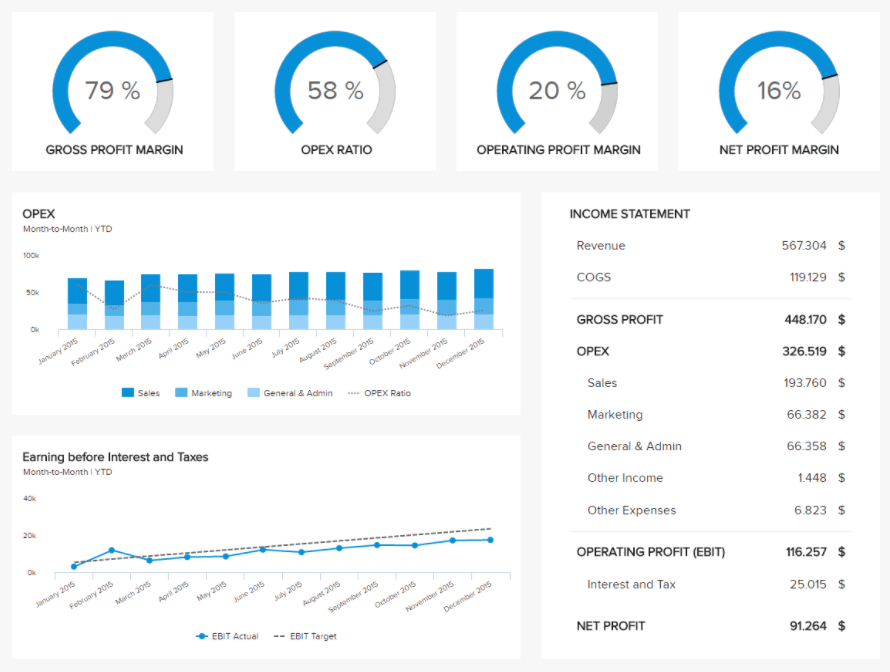
Return on equity (ROE): Calculates the profit your company generates for your shareholders. It is used to compare profitability amongst businesses in the same industry.
Here, we will look at these kinds of reports in greater detail, delving into daily and weekly reports, but focusing mainly on monthly financial reports and examples you can use for creating your own statements and reports, which we will present and explain later in the article alongside their relevance in today’s fast-paced, hyper-connected business world.
Return on assets (ROA): Shows how profitable your businesses are compared to your total assets. Assets include both debt and equity.
Quick ratio/acid test: A KPI that offers instant insights as well as results, this metric serves up critical information concerning liquidity.
**click to enlarge**
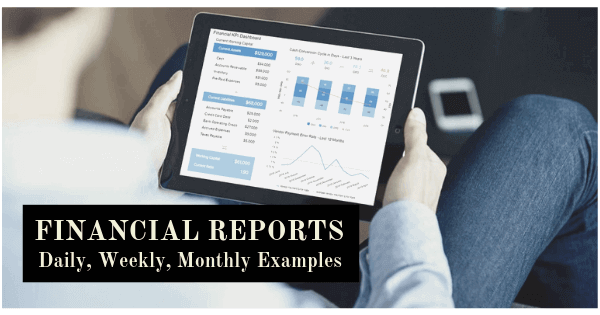
- This KPI is a crucial measurement of production efficiency within your organization. Costs may include the price of labor and materials but exclude distribution and rent expenses.
- For example, if your gross profit margin was 30% last year, you would keep 30 cents out of every dollar earned and apply it towards administration, marketing, and other expenses. On a weekly basis, it makes sense to track this KPI in order to keep an eye on the development of your revenue, especially if you run short promotions to increase the number of purchases. Here is a visual example:
"I believe that through knowledge and discipline, financial peace is possible for all of us" – Dave Ramsey, radio host and financial expert
- If you see that most costs come from administrational activities, you should consider automating tasks as much as possible. By utilizing self service analytics tools, each professional in your team will be equipped to explore and generate insights on their own, without burdening other departments and saving countless working hours.
- Generally, costs should not be looked upon purely on the base of black and white. If sales and marketing cause cost increment, maybe they also deliver high volumes of revenue so the balance is healthy, and not negative.
To help you understand how you can benefit from financial visualizations, here are 5 monthly report examples, complete with explanatory insight and a deeper insight into their respective KPIs.

